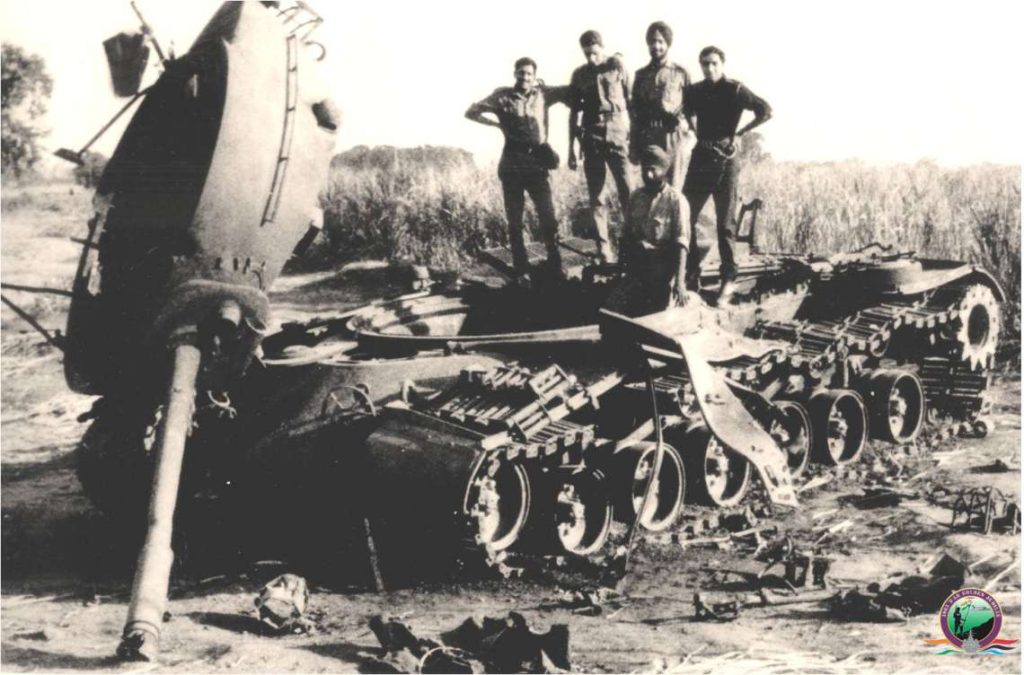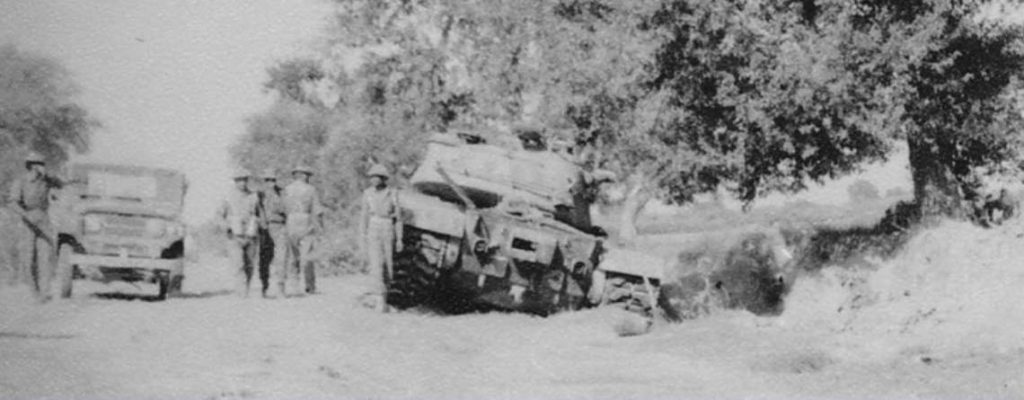This three-day clash near the India-Pakistan border in Punjab’s Khem Karan sector was a decisive turning point in the 1965 Indo-Pak War, showcasing the Indian Army’s strategic brilliance, resilience and unyielding courage against a formidable Pakistani offensive, writes Major General RPS Bhadauria (Retd)

The Battle of Asal Uttar, fought from 8-10 September 1965, stands as a monumental chapter in India’s military history, often likened to the epic tank battle of Kursk during World War II. This three-day clash near the India-Pakistan border in Punjab’s Khem Karan sector was a decisive turning point in the 1965 Indo-Pak War, showcasing the Indian Army’s strategic brilliance, resilience and unyielding courage against a formidable Pakistani offensive. At the heart of this battle lies the legendary heroism of Company Quarter Master Havildar (CQMH) Abdul Hamid, whose sacrifice earned him India’s highest military honour, the Param Vir Chakra. This article explores the prelude, events and enduring legacy of the Battle of Asal Uttar, paying tribute to the soldiers who transformed a dire situation into a resounding victory.
The Prelude: A Geopolitical Chessboard
The 1965 Indo-Pak War was rooted in Pakistan’s long-standing ambition to seize Jammu and Kashmir, a goal fuelled by strategic alliances and Cold War dynamics. Under General Ayub Khan, Pakistan cultivated close ties with the United States through its membership in Southeast Asia Treaty Organisation (SEATO) and Central Treaty Organisation (CENTO) during the 1950s.
These alliances secured advanced weaponry, including the American-made M47 and M48 Patton tanks, which were considered among the most advanced tanks of their time. Pakistan’s arsenal also included modern artillery, anti-tank missiles and a well-equipped air force and navy, giving them a significant technological edge. In 1963, Pakistan further strengthened its position by forging closer ties with China, ceding parts of illegally occupied Jammu and Kashmir in a boundary agreement.
This move secured Chinese support for Pakistan’s territorial ambitions, particularly after China’s victory over India in the 1962 Sino-Indian War. Emboldened by these alliances, Pakistan believed it could exploit India’s perceived vulnerabilities. Gen Ayub Khan famously wrote to his commander, Gen Musa, that “Hindu morale would not stand for more than a couple of hard blows delivered at the right time and place,” reflecting Pakistan’s underestimation of Indian resolve.

India, meanwhile, was recovering from the 1962 debacle against China. The Indian Army, constrained by a modest defence budget, relied on outdated tanks like the British Centurion Mk VII, French AMX-13 and M4 Sherman, which were inferior to the Patton in firepower and mobility. India’s commitment to the Non-Aligned Movement (NAM) and its neutral stance during the Cold War limited its access to advanced Western weaponry. While the US briefly warmed to India after 1962, President Lyndon Johnson’s administration reversed this policy, leaving India to rely on limited Soviet support and its own ingenuity.
The war’s opening salvo came in April 1965 with Pakistan’s Operation Desert Hawk in the Rann of Kutch, a barren region in Gujarat. Pakistan’s success in capturing territory there boosted its confidence, setting the stage for a larger offensive. In Aug 1965, Pakistan launched Operation Gibraltar, infiltrating 30,000 commandos into Kashmir to incite an insurrection. The operation backfired as Kashmiri locals, loyal to India, alerted the Indian Army, neutralising the infiltrators. India retaliated by capturing the strategic Haji Pir Pass in Pakistan-occupied Kashmir, escalating the conflict.
To relieve pressure in Kashmir, Pakistan shifted its focus to Punjab, launching a major offensive with its 1st Armoured Division and 11th Infantry Division. On 6 September, Pakistani forces captured Khem Karan, a small Indian town 5 kilometres inside the border, aiming to cut off Amritsar and sever Punjab’s supply lines. This set the stage for the Battle of Asal Uttar, where India would deliver a decisive blow.
The Battle: A Strategic Masterstroke
The fall of Khem Karan placed the Indian 4th Mountain Division, under Maj Gen Gurbaksh Singh, in a precarious position. Outnumbered and outgunned, with no reserves left after deploying the 2nd Armoured Brigade, the Indian troops faced a do-or-die situation. Pakistan’s 1st Armoured Division, equipped with over 220 Patton tanks, aimed to advance toward Amritsar, threatening to isolate Punjab and cripple India’s war effort. Retreat was not an option, as the loss of Amritsar would have been catastrophic.
Gen Singh devised a bold defensive strategy, ordering his forces to fall back and form a horseshoe-shaped defensive position around the village of Asal Uttar, meaning “fitting reply” in Hindi. The terrain around Asal Uttar, with its unharvested sugarcane fields and swampy ground, offered a natural advantage. Under the cover of night, Indian troops flooded the fields, creating a quagmire that would impede heavy tanks. This tactical manoeuvre transformed the battlefield into a trap for Pakistan’s armoured division.
On the morning of 8 Sep, Pakistan’s 1st Armoured Division advanced, confident of a swift victory. Lured into the horseshoe formation, their Patton tanks became mired in the muddy, waterlogged fields. The tall sugarcane stalks concealed Indian troops, who were equipped with outdated Centurion, Sherman and AMX-13 tanks, as well as anti-tank weapons like recoilless rifles. From their hidden positions, the Indian forces unleashed a devastating counteroffensive, targeting the immobilised Pakistani tanks with precision.

Over the three-day battle, India destroyed over 100 Pakistani tanks, primarily Patton tanks and captured another 40, while losing only 10 of their own. The area around Asal Uttar became known as “Patton Nagar,” or the “Graveyard of Patton Tanks,” symbolising the destruction of Pakistan’s prized armoured division. The battle also claimed the life of Pakistani commander Maj Gen Nasir Ahmed Khan, further demoralising their forces. The Indian victory at Asal Uttar shattered Pakistan’s ambition to capture Amritsar and marked a turning point in the war, proving that strategy and courage could overcome technological superiority.
The Heroism of Abdul Hamid
At the heart of the Battle of Asal Uttar is the story of CQMH Abdul Hamid, a soldier whose bravery became a symbol of Indian valour. Born in Dhamupur, Uttar Pradesh, Hamid joined the Indian Army at 21 and was stationed with the 4th Grenadiers during the battle. Deployed on the outskirts of Chima village along the Amritsar-Khem Karan road, Hamid was tasked with neutralising enemy tanks using a recoilless rifle mounted on a jeep—a modest weapon compared to the formidable Patton tanks.
On 10 September, as Pakistani tanks advanced through the sugarcane fields, Hamid displayed extraordinary courage. Spotting a group of four Patton tanks, he manoeuvred his jeep to point-blank range, engaging the enemy with remarkable precision. He destroyed three tanks in quick succession, disrupting the Pakistani advance and saving countless Indian lives. As he targeted a fourth tank, Hamid came under heavy enemy fire and was killed in action. His sacrifice earned him the nickname “Patton Killer” and the Param Vir Chakra, awarded posthumously for his unparalleled bravery.
Hamid’s actions not only inflicted significant losses on the enemy but also inspired his comrades to fight with renewed determination. His grave and a war memorial at Chima village in Punjab’s Tarn Taran district stand as enduring tributes to his sacrifice. Hamid’s story transcends communal boundaries, embodying the unity and sacrifice that define India’s military ethos.
The Aftermath: A Decisive Victory
The Battle of Asal Uttar concluded on 10 September 1965, with a resounding Indian victory that altered the course of the war. Pakistan’s losses were staggering—over 165 tanks, according to Indian accounts—severely weakening their armoured capabilities. The myth of the Patton tank’s invincibility was shattered, prompting Pakistan to phase it out in favour of the M60. The war ended on 23 Sep, with a UN-mandated ceasefire. Both nations had captured territories from each other, with India holding the larger share. The Tashkent Agreement of 1966 facilitated the return of all territories, including Khem Karan, to India. The battle’s significance extends beyond its immediate outcome. It demonstrated the Indian Army’s ability to overcome technological and numerical disadvantages through strategic ingenuity and sheer determination. The horseshoe trap, conceived by Major General Gurbaksh Singh, remains a case study in military tactics that is taught in academies worldwide. The victory at Asal Uttar also had geopolitical ramifications, as India and Pakistan reevaluated their international alliances. Disillusioned by perceived lack of support from the US and UK, India strengthened ties with the Soviet Union, while Pakistan deepened its relationship with China.
Maj Gen. RPS Bhadauria (Retd) is the Additional Director General of the Centre for Land Warfare Studies (CLAWS), New Delhi, and was formerly the Director of the Centre for Strategic Studies & Simulation (CS3) at USI of India, having served in the Indian Army for 36 years.











